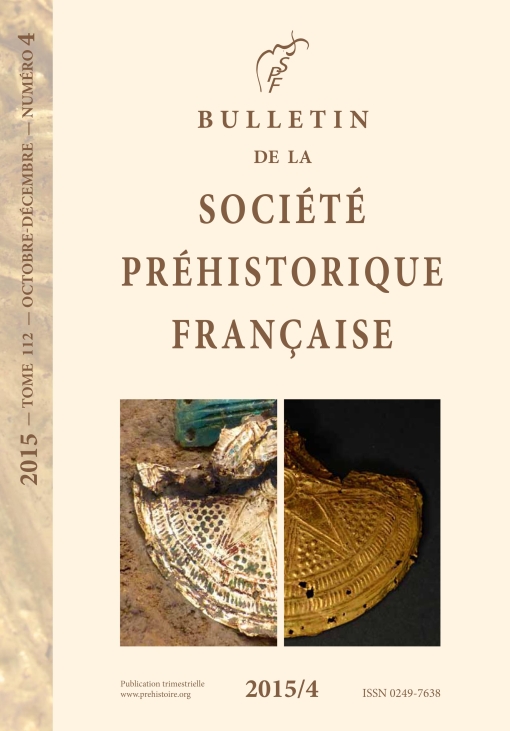15-2015, tome 112, 4, 2015, p. 647-692 - Nejma Goutas - Données inédites sur le Gravettien oriental : apport de la technologie osseuse à la caractérisation des occupations de Kostienki 4 (Alexandrovska, région de Voronej, Russie)
Le Gravettien oriental est encore trop souvent réduit à sa manifestation la plus spectaculaire : la « culture de Kostienki-Avdeevo ». Certains sites ont pourtant livré des industries lithiques qui s'en démarquent très nettement. C'est le cas du gisement de Kostienki 4 auquel nous consacrons cette étude. Ce site a livré deux occupations généralement rapportées au Gravettien lato sensu, et prenant place entre 21000 et 23000 uncal. BP. L'ancienneté des fouilles, autant que l'absence d'études archéozoologiques rendent la documentation disponible souvent parcellaire. En confrontant, pour la première fois, les données inédites de l'industrie en matières dures d'origine animale de Kostienki 4, aux autres sphères de la culture matérielle, nous avons pu mettre en évidence de nouveaux éléments de caractérisation de ses deux phases d'occupation. Nous verrons que ce sont des groupes indubitablement différents qui s'y sont succédés, et probablement à différentes saisons de l'année. Des différences majeures transparaissent dans les matières osseuses exploitées, dans leur transformation et leur utilisation, questionnant sur la pertinence d'un rattachement de ces deux niveaux d'occupation à une même entité culturelle. Enfin, les différences observées entre les deux habitats du niveau inférieur, nous permettront de discuter d'une éventuelle différentiation fonctionnelle ou sociale de l'espace.
Although the Eastern Gravettian culture is famous for its mammoth ivory objects (sculptures, decorated objects, tools), very few techno-economic analyses of the industries made of other osseous materials have been undertaken. The characterization of know-how in these societies, which is very particular in many ways, is an underexploited area of investigation in relation to the potential information that can be drawn from it. The Eastern Gravettian is, moreover, still often reduced to its most spectacular expression: the ???Kostienki-Avdeevo culture???. Some sites have however yielded outstanding lithic industries, showing strong affinities with certain industries in Western Europe. This is the case for Kostienki 4, to which we dedicate this study. This site has yielded two layers deposited between 23000 and 21000 uncal. BP. The age of the excavations as well as the absence of essential data such as archaeozoological studies make the available documentation often incomplete. Taking into account, for the first time, all the data on the osseous industry from this site, and comparing them with other material culture data, we identified new characterization criteria for both the archaeological layers of Kostienki 4. We will demonstrate that different groups undoubtedly succeeded each other on this site, and probably at different seasons of the year. Major differences are well reflected in the raw materials used in the osseous industry, in their processing and their use. These differences were already evoked by the data on the lithic industry and the radiocarbon results as well as by the spatial structures of the site, which differ greatly between the two occupation levels. There also appear to be differences in the game hunted, reflecting a change in subsistence strategies between the two layers. These were probably also conditioned by the season and the duration of the occupation of each level. Fur-bearing animals, primarily hare, hold a significant place in the economy of the inhabitants of the lower layer (hide working, bone tools), whereas this type of game has become marginal in the upper layer. These economic differences are accompanied by major changes in the field of symbolic production. The nature of the ornaments made of osseous materials was dramatically modified during the occupation of the site, and many soft stone figurines appear in the upper layer, as do new techniques, such as the polishing of stone, the extraction of rods by the groove-and-splinter technique, and the extraction of discs by bifacial circular grooving. The upper layer is also the only one which yielded some highly invested objects (geometric designs, a higher transformation factor).
Beyond these differences between the two layers of the site, there are also differences (distribution of the game hunted, osseous equipment) between the two settlement areas of the lower level. They reflect a possible functional differentiation and perhaps even a social differentiation of the domestic space. Ultimately, all these elements raise questions about the relevance of linking the two archaeological layers to the same cultural entity.



